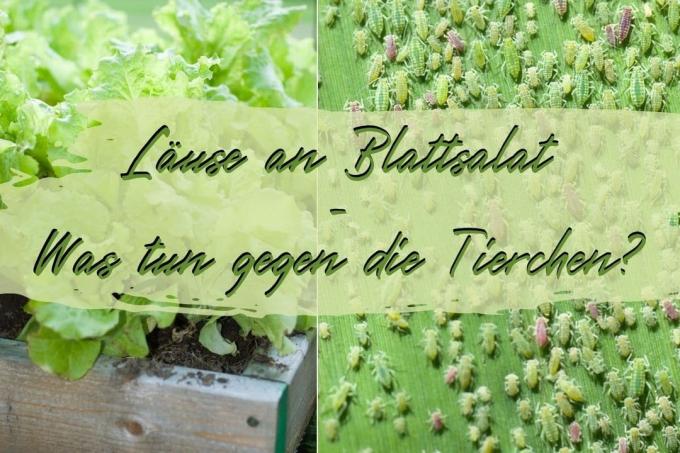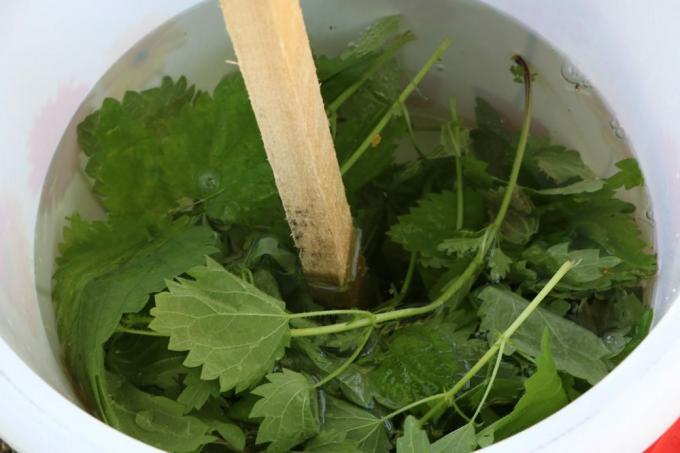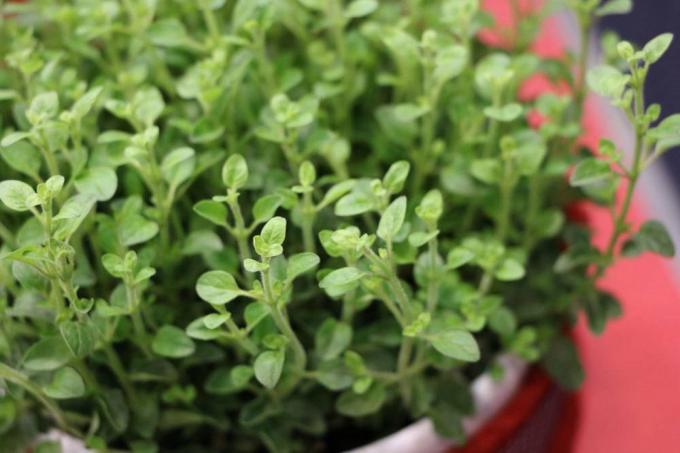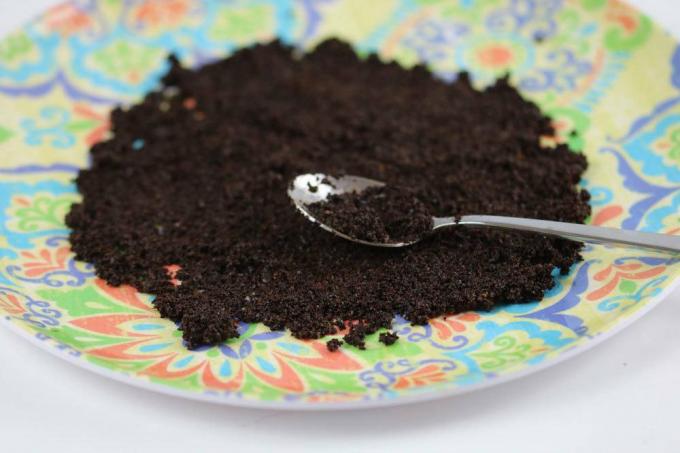
table of contents
- Various causes are possible
- Detecting the lice
- Plant stock
- Oregano tea
- Potato water
- Milk-water mixture
- Rapeseed oil
- Coffee grounds
- Natural predators
- Mixed culture
- frequently asked Questions
Fresh, crunchy lettuce from the garden is an enrichment for every menu. Too bad that it is also very popular with aphids. You can find out how to fight the lice below.
In a nutshell
- Over-fertilization, wrong location, warm and humid weather favor infestation
- Deformed leaves, sticky leaf coating, ants indicate the presence of aphids
- do not fight with chemistry
- various home remedies serve well
Various causes are possible
There is not just one cause of leaf lettuce infestation with aphids (aphidoidea). Various factors play a role in this. It is important that the earlier an infestation is detected, the sooner something can be done against these pests. Causes can be:

- Over-fertilization of the soil with nitrogen
- wrongly chosen location
- only cultivation of monocultures
- insufficient plant spacing
- poor air circulation between plants
- humid and warm weather
- poor plant vitality
Detecting the lice
The lice, which are only two to four millimeters in size, can be seen with the naked eye if you look closely. They can come in different colors from black to reddish brown to green. The nuisances that spread in the salad are a little more difficult to see. Usually they hide deep in the leaves. Sure signs of the presence of lice are:
- deformed and curled leaves
- sticky leaf coating (honeydew)
- bad growth
- a flock of ants
- partially existing soot fungus
If an infestation is found, quick action is necessary to prevent further spread and reproduction of the lice.

Tip: Infested leaf lettuce must be washed thoroughly before preparation in the kitchen. To do this, a little salt and a few dashes of vinegar should be added to the cold water. The leaves should stay in it for two minutes.
To put an end to the aphids, you shouldn't use the chemical club straight away. This can not only be harmful to human health, but also has lasting damage to the environment with its useful helpers such as insects and other microorganisms. In the case of a slight infestation, wiping the leaves by hand or a light jet of water from the garden hose is sufficient. In addition, various home remedies can be used to combat the lice in lettuce. Below is a small list.
Plant stock
Nettle stock
This brew not only drives away lice, but also strengthens the plants' defenses at the same time. The production is simple:
- Chop 100 g of fresh nettles
- do not use flowers
- then fill up with 1 liter of cold water
- Let it steep for at least 12 to 24 hours
- choose a sunny, warm place for it
- then bring the mixture to the boil for 20 minutes
- cool, strain and transfer to a squirt bottle
- Use every two to three days
If possible, rainwater should be used for the production.
Note: Adding a little wood ash can soften the smell of the brew.

Horsetail brew
The broth strengthens the cell structure and protects against aphids, powdery mildew, gray mold and scabs.
- 1 kg of fresh or 200 g of dried cabbage
- Add 10 liters of water
- Let it steep for 24 hours in a warm place
- then cook for 30 minutes
- Let cool and strain
- Dilute 2 liters of brew with 10 liters of water
- Spray plants every 2 to 3 days
- also use as irrigation water
Note: The brew is only effective against aphids in the early stages, but can be used preventively against them.
Garlic and onion stock
- Chop 40 g of garlic cloves or onions
- Pour 1 liter of boiling water over it
- Let it steep for 3 hours
- strain, transfer to a squirt bottle
- Use several times a day
Note: The brew also helps against fungal diseases. Alternatively, garlic can also be planted between the leafy lettuce. The smell scares the animals off.
Oregano tea
- 100 g of fresh oregano or 10 g of dried oregano per liter of water
- Pour one liter of boiling water over the cabbage
- Let it steep for 30 minutes
- strain
- Use only diluted
- Ratio 3: 1 with water
- Spray several times a day every 1 to 2 days

Tip: Alternatively, wormwood or black tea (two tea bags) can be used.
Potato water
The solanine that escapes when potatoes is cooked is not at all liked by aphids. Simply let the cooking water cool down and then spray the plants undiluted with it every one or two days.
Milk-water mixture
- 1 liter of fresh milk, no long-life milk
- 1 liter of cold water
- mix everything
- Spray plants once or twice a day
Rapeseed oil
- 100 ml of oil
- 5 liters of water
- 1 to 2 dashes of detergent
- mix everything well
- Spray plants daily
- successes already visible after the third application
Coffee grounds
Coffee grounds make great fertilizers and are a good home remedy for controlling aphids.

- 4 tablespoons of coffee grounds
- 1 liter of water
- 1 tablespoon of milk
- Brew the coffee grounds again
- cooling down
- Add milk
- spray plants for a few days
Tip: Alternatively, leftover cold filter coffee can also be used.
Natural predators
The spread of the pests can be prevented in a natural way through the use of predators. These can find shelter in an insect hotel and can thus be used specifically in the beds. Larvae of these animals can be obtained on the Internet. Natural predators include:
- Ladybug
- Gall mosquitoes
- Hoverflies and lacewings
- Parasitic wasps
- Catchy tunes
Note: A ladybug can eat up to 150 aphids per day. The larvae have a particularly large appetite.
Mixed culture
The planting of different scented plants between the individual leaf salads has also proven itself. The emitted scent drives the lice away. These include:

- Tagetes
- Savory and sage
- Garlic and onions
- Anise and coriander
- Lavender and mint
- parsley
frequently asked Questions
The animals are completely harmless to humans, even if they may be eaten. They do not bite or sting, nor are they poisonous. However, they can cause harm to the affected plants. They suck out the sap with their proboscis. The development of the plants is disturbed. In the worst case, they die. A major crop failure can occur. In addition, they can transmit viruses and fungal diseases can develop.
Initially, the lice are sexless. However, they become sexually mature within just a few weeks. Such an animal can then produce up to five offspring per day. If not controlled, the aphids can form large colonies in a short time.
Prevention is not only possible with lettuce, but with all plants. Enriching the soil with nitrogen can be very helpful, but do not over-fertilize. Otherwise this can become a cause of an infestation. A suitable location with sufficient plant spacing is also important. Regular watering is also necessary, but avoid waterlogging. Choosing aphid-resistant varieties can also help, as can setting up an insect hotel.



